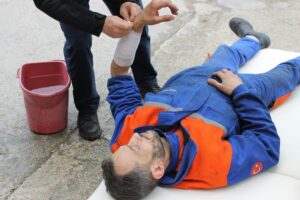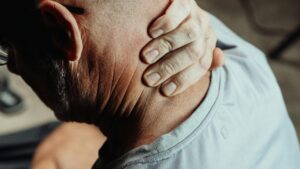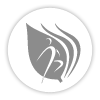 Work injuries include a wide variety of problems from sprains or strains of muscles to a fracture or a break. Physical therapy can help by providing a thorough evaluation, designing and individual treatment plan that may include education in posture, ergonomics or proper lifting mechanics, manual therapy to help with problems with alignment and increased muscle tonicity and exercises to help promote balance and strength around the injured area with an emphasis on return to work and prevention of further re-occurrence.
Work injuries include a wide variety of problems from sprains or strains of muscles to a fracture or a break. Physical therapy can help by providing a thorough evaluation, designing and individual treatment plan that may include education in posture, ergonomics or proper lifting mechanics, manual therapy to help with problems with alignment and increased muscle tonicity and exercises to help promote balance and strength around the injured area with an emphasis on return to work and prevention of further re-occurrence.
Archives: Conditions
Holds our conditions and condition-specific data
Womens Health
Women’s health issues may include problems with incontinence, pre and post partum weakness/pain, and pain in the pelvic floor region which can occur gradually, through trauma, or even after surgery. Physical Therapy can help with scar mobilization, education in techniques to help with voiding schedules and posture and exercises to help strengthen the pelvic floor and surrounding musculature.
Whiplash
 Whiplash injuries are often sustained in a rear end motor vehicle accident. The head is often thrust forward and then backward at a high velocity which overstretches and may also compress the muscles, structures and vertebrae of the cervical spine. Physical therapy can help to address the alignment problems, soft tissue damage, and stretching and strengthening needed to restore optimal function. Pleas also see car accident and motor vehicle definitions.
Whiplash injuries are often sustained in a rear end motor vehicle accident. The head is often thrust forward and then backward at a high velocity which overstretches and may also compress the muscles, structures and vertebrae of the cervical spine. Physical therapy can help to address the alignment problems, soft tissue damage, and stretching and strengthening needed to restore optimal function. Pleas also see car accident and motor vehicle definitions.
Neural Fibrosis
Neural fibrosis is a thickening or scarring around a nerve. This may be caused by repeated traction, friction or rubbing, constriction or potential rupture of the nerve. At Goodell Physical Therapy a thorough evaluation will be performed and an individualized treatment plan implemented to help patient by decreasing the scarring with manual therapy, assist the structures in proper healing, and educate patients in promoting postures that alleviate pressure on the nerve and retraining postures that contribute toward nerve problems.
Nerve Pain
Nerve pain is also called neuralgia. Is can be caused by injury, inflammation, compression, disease and nerve degeneration. Nerve pain can follow the path of a specific nerve and may involve weakness and/or decreased or absent sensation. Physical therapy can help patients regain strength, centralize the symptoms so the pain is not spread our and educate the patient in preventative measures.
Numbness
Numbness is also known as paresthesia. It is a sensation of a person’s skin that may be described as pins and needles, tingling, or a limb being “asleep”. Numbness may come and go or be more constant. Constant numbness may be a problem with the function of neurons. This may be due to poor circulation, vitamin deficiency or a metabolic problem such as hypothyroidism or diabetes. Nerves can also become inflamed contributing toward numbness. Neck and spine problems may compress nerves and muscle cramps, bad posture, unsafe lifting practices and physical trauma can all contribute towards potential numbness. Physical therapy can help through a thorough evaluation identifying the problem, trying conservative measures such as education in posture, nutrition, manual techniques to help with spinal alignment and myofascial release, and individualized exercises to increase balance and strength.
Muscle Strain / Muscle Tear
After an injury, muscles may spasm, become strained, or even tear. Muscle spasms are tight muscles that usually occur early after an injury. Muscle strains, also called pulled muscles, occur when a muscle or tendon that attaches it to the bone is overstretched or torn. Muscle strains may occur because of improper stretching, lack of warm up, too weak or previously injured and has not had adequate time to recover. At Goodell Physical Therapy a thorough evaluation is performed, exercise and patient education is emphasized to help you recover from and prevent further injury.
Low Back Pain
Low back pain is a common complaint among both genders and affects most all occupations and age groups. Almost everyone experiences back pain at some point in their life. At Goodell Physical Therapy a thorough evaluation is performed and individualized goals and a treatment plan are designed. Patients are educated in proper posture, body mechanics and ergonomics to help protect their spine. Exercises for strengthening, stretching, and stabilization are often provided with the goal of preventing further injury and return to individually desired activities.
Kegel Exercises
Kegel exercises help strengthen the muscles of the pelvic floor which help support the bladder and sphincter muscles. If the muscles are already weak, people may have difficulty identifying and isolating the muscles of the pelvic floor. At Goodell Physical Therapy we can help make sure exercise is performed correctly and design a resistance program tailored to fit your needs.
Ligament Injuries
Ligaments connect bone to bone and help provide stability within a joint. There are different levels of sprains to a ligament and if the injury is significant a tear may result. Some ligament tears may require surgery. It is possible to damage more than one ligament in the same incident. Ligament Injuries commonly occur in the shoulder, knee, and ankle. The most common ligament injuries in the knee include the anterior cruciate ligament (ACL), medical collateral ligament (MCL), and less commonly the lateral collateral ligament (LCL), and the posterior cruciate ligament (PCL). Physical therapy can help patients with ligamentous injuries to help strengthen structures surrounding the joint. Patients will also benefit from physical therapy post surgery to help ensure a quick and complete recovery.
